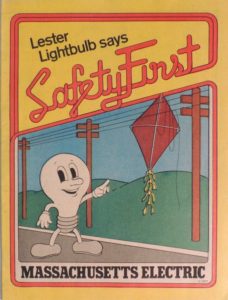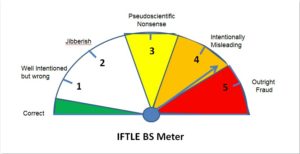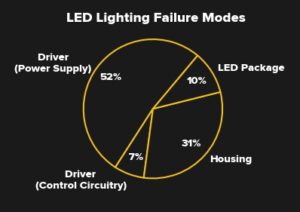In the past few weeks, a reader sent a message to IFTLE titled “Time to bring back Lester the Lightbulb” with a link to a story in the Detroit News.
Way back in Aug of 2011, I was covering the forced introduction of light-emitting diode (LED) light bulbs into the US consumer market. Although incandescent light bulbs have nothing to do with advanced heterogeneous integration packaging, the newer LED bulbs certainly would. For any new readers, I will briefly go over that history [see IFTLE 63 “Bidding Adieu to Lester Lightbulb” and IFTLE 113 “An Exclusive Interview with Mr. Lester Lightbulb” for the full story.)
Lester’s Story

During the decade that my sons were growing up in Holliston Massachusetts, Massachusetts Electric had a great commercial on TV called “Lester the Lightbulb”. Basically, Lester was an incandescent light bulb with a smiley cartoon face on it who told kids to remember to shut off the light when not in use and to not to put things into the electrical sockets. Lester was beloved in Mass. We can certainly all agree that advertising to save energy is a good thing. In 2011 the Department of Energy (DOE) published their roadmap calling for the extinction of the incandescent bulbs. Lester, sitting on death row, through his mouthpiece IFTLE, called FOUL.
While no one could argue the point that LED-based bulbs certainly used less power, Lester’s defensive position was two-fold:
- Does it really make sense to replace a 25 cent lightbulb with a 45 dollar light bulb (2011 cost), no matter how long it lasts?
- Are the reported lifetimes realistic or simply marketing hype? For instance, 3M actually claimed that their new LED lightbulb was designed to burn for 25 years based on their lifetime “projections”.
IFTLE took the position that for a small home with say 50 lightbulbs (low estimate), it would have cost $2250 to replace all the bulbs with LEDs (2011 cost). IFTLE was convinced that more energy savings would come from using that money to install an energy efficient heater or air conditioner or refrigerator (things with power-hungry motors) than replacing light bulbs. (Go back and read the old blogs to follow the math.)
In addition, when looking at the construction of LED lightbulbs (versus a tungsten filament incandescent) IFTLE saw significant complexity which went against the well-worn axiom “keep it simple stupid!” (Figure 2).

When going over the tests that were run to verify the reliability, IFTLE noticed that they were testing the LED chips, not the full bulb fixtures. The data showed the chips were rugged and long lasting but that inferred nothing about the full bulbs. Lester and IFTLE concluded that the lifetime of the bulb would be limited by the shortest lifetime of any of the components inside the bulb (science 101!!).

Thus, IFTLE brought out the BS meter (Figure 3) and labeled the consumer push for the adoption of LED lightbulbs somewhere between intentionally misleading and outright fraud!
 t that time Philips was selling the 60-watt “EnduraLED”, at the local hardware store (Home Depot) for $47 with a 6-year warranty. IFTLE bought one and installed it in a kitchen fixture where it has been since the summer of 2011 (Figure 4).
t that time Philips was selling the 60-watt “EnduraLED”, at the local hardware store (Home Depot) for $47 with a 6-year warranty. IFTLE bought one and installed it in a kitchen fixture where it has been since the summer of 2011 (Figure 4).
The good news is that the bulb you see pictured has been operational for a full 8 years at an estimated 4 hours per day for somewhere around 12,000 hrs. As you will read below this may have been just luck, i.e I got a good one.
But, more importantly from an economic standpoint …. the incandescent that was put into a floor lamp in my den at the same time is also still operational after the same 8-year period, after being turned on every day for approximately the same four-hour period, although the LED literature would have you believe that the average lifetime for an incandescent is less than four months.
As you may surmise, the current status of Lester vs the LED (currently tied at 8 years) is not the point of this blog. The link sent on by the unknown reader had the following headline:
Detroit’s LED streetlights going dark after a few years
Detroit’s lighting authority has announced that tens of thousands of Detroit’s more than 65,000 streetlights have failed just a few years after being installed. The 2014-16 lighting project cost Detroit $185M. Their LED lighting supplier has determined that “the problem is excessive heat that can burn the lens directly above the LED.” Sounds like the street lights were only as good as the weakest elements! (Who would have thunk it?)
That led me to the Feb 2019 article:
Berkeley to replace all its LED streetlights due to elevated failure rates
In 2014, Berkeley also began replacing its high-pressure sodium lamps with 8,000 LED fixtures. The LEDs were supposed to last 15-17 years. In early 2018 the LEDs began to fail all over town at a higher-than-expected rate.
So what about our consumer indoor LED light bulbs?
Cree was one of the US companies pressuring the DOE to make the move to LED lighting, citing economic and environmental reasons. Ads for Cree LEDs promise a 10-year warranty, a “100% Satisfaction Guaranteed,” and representations that its bulbs were “designed to last more than 25,000 hours.” But some consumers disagree, citing their own experience of Cree LED bulbs failing within months.
In April 2019, a New York woman filed a class action lawsuit against Cree, accusing the company lured consumers into purchasing defective LED bulbs by falsely advertising that the bulbs would last a long time, be energy efficient and save the consumer money over the long-term.
In the article “The big lie about LED lighting” Scott Elder, a 28-year engineer at Linear Technology, detailed his experiences with using LED bulbs in his home. He commented “I did a ..reliability analysis on Amazon.com, looking at the ratings for LED lamps. Out of 400 reviews, 25 people gave a popular $10 LED lamp a rating of one. I started reading through the one-star reviews and virtually everyone who scored the lamp as a one claimed their score was because the lamps failed very quickly. Even most of the 18 people who scored the lamp a two did so because of failure….”

Finally in the Feb 2019 article “What Happened to the 100,000-Hour LED Bulbs?” the author notes that the lifetime and reliability fact sheet on the DOE’s website contains data on the failure rate of 5,400 outdoor lamps over 34 million hours of operation. That data is shown below where you can see that the power supply caused a majority of the failures.
Searching for reasons why LED lighting failures are occurring, I found the following article “Four Reasons LED Lamps Fail Prematurely”.
According to the article, 4 reasons predominate:
- Use of poor-quality materials
Commercially available LEDs comprise several components (aside from the LED chip)…From the type of lens to the heat sink and the chips and power supplies that generate light, all LED components must last if the lamp is expected to function properly and provide acceptable light output. Quality materials matter. ….Take LED drivers, for example. A driver converts AC power into DC power so an LED can operate. If poor-quality components are used to construct the driver, the LED may fail, if the correct driver isn’t used, the heat generated by the driver may be difficult to dissipate and cause failure. This is often why LEDs flash or flicker — it’s an early sign of driver failure. - Inadequate lamp testing
As solid-state electronic devices, LEDs …. tend to fail early if they’re going to fail at all. By properly testing LEDs, manufacturers can catch failures before the lamps are shipped. - Thermal Issues
LEDs shouldn’t be placed in tightly enclosed fixtures unless they’re approved for enclosed spaces. When heat can’t dissipate from the heat sink, it can cause lamps to fail. Adequate thermal management is key to making sure that LEDs will last in hot environments. - Lamps are counterfeit
Counterfeit LED lighting products are made to look similar to reputable brands, sometimes even using identical markings, part numbers, logos, and packaging (but they are fake).
2019 Conclusions:
So what is the IFTLE conclusion 8 years after we initially looked into this matter? Was Lester the lightbulb put to death based on fraud and deceit? Basically YES…does anyone really believe that the DOE and its engineers or companies like Cree and GE didn’t know that the lighting devices would only be as reliable as their weakest component? Did any of them really believe that lighting devices containing cheap drivers and electrolytic capacitors would last 25 years? Is it possible they did not understand the thermal requirements of LED lighting devices? I think not.
Note: These conclusions are strictly technology and economics based and do not even take into account recent reports from Harvard about outdoor LED street lighting that stated “When the environment is saturated with blue-rich light it causes melatonin reduction which can affect sleep…Light at night is bad for your health, and exposure to blue light emitted by electronics and energy-efficient lightbulbs may be especially so.” While people can certainly close their blinds and block-out the blue-white light other species can’t do that, animals, plants, trees, etc. Think about that, hard-core environmentalists!
Rest-in-peace Lester Lightbulb…there are still those fighting to avenge you!
For all the latest on Advanced Packaging stay linked to IFTLE…





















